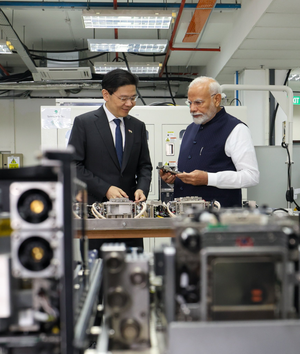Context:
Recently, the Union Cabinet has approved Kaynes Semicon proposal to set up a semiconductor unit in Sanand, Gujarat.
More on the news
- This is the fifth semiconductor unit to be approved under the India Semiconductor Mission (ISM), the second to be set up in Sanand.
- The new Kaynes Semicon unit will handle assembly, testing, marking, and packaging (ATMP) and is expected to produce around 6 million chips per day.
- These chips will be used in various sectors including automotive, electric vehicles, consumer electronics, telecom equipment, and mobile phones.
- The Programme for Development of Semiconductors and Display Manufacturing Ecosystem in India was notified on December 21, 2021.
- Earlier, in February, the Centre approved three semiconductor units: Tata Electronics will establish a fab in Dholera, Gujarat, and another unit in Morigaon, Assam, while CG Power will set up a unit in Sanand.
India Semiconductor Mission (ISM)
- It is a specialized division within the Digital India Corporation focused on building a semiconductor and display ecosystem.
- Its goal is to make India a global hub for electronics manufacturing and design.
- In 2021, the Union Cabinet approved the Semicon India program with INR 76,000 crore to develop a sustainable semiconductor and display ecosystem.
Key Objectives:
- Incentives: Provide support to companies involved in semiconductor fabs, display fabs, compound semiconductors, sensors, packaging, and design.
- Capital and Collaboration: Facilitate manufacturing through financial support and technological partnerships.
Vision:
- ISM aims to create a vibrant semiconductor and display ecosystem to boost India’s position as a global electronics hub, using structured and focused approaches.
Schemes under India Semiconductor Mission (ISM)
- Semiconductor Fabs Scheme: Provides 50% fiscal support for setting up Silicon CMOS-based semiconductor wafer fabrication facilities in India.
- Display Fabs Scheme: Offers 50% fiscal support for establishing TFT LCD or AMOLED display panel manufacturing facilities.
- Compound Semiconductors and ATMP Scheme: Extends fiscal support for capital expenditure on setting up facilities for Compound Semiconductors, Silicon Photonics, Sensors, Discrete Semiconductors, and Semiconductor Assembly, Testing, Marking, and Packaging (ATMP) units.
- Design Linked Incentive (DLI) Scheme: Offers financial incentives and design infrastructure support for semiconductor design, including ICs, Chipsets, SoCs, and Systems over a period of 5 years.
Reasons for Setting Up Semiconductor Units in India
- Economic Growth and Job Creation: Generate about 20,000 high-tech jobs and 60,000 additional roles, driving economic growth and opportunities in technology sectors.
- Boosting Domestic Semiconductor Production: India currently relies heavily on importing semiconductors, with about 70% of global production coming from South Korea, Taiwan, China, the US, and Japan. By setting up new semiconductor manufacturing units, India aims to reduce its dependence on these imports and build its own semiconductor industry.
- Supporting the Broader Electronics Industry: Expanding semiconductor manufacturing will ensure a steady supply of essential components for rapidly growing sectors like electric vehicles (EVs), telecommunications, and consumer electronics.

